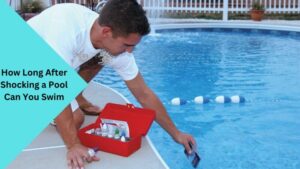Your swimming pool can be the heart of exhilarating fun and relaxation, especially during the sun-splashed days of summer. However, maintaining its cleanliness should be a priority to ensure a healthy swimming environment. One such maintenance task is “shocking” the pool, or super-chlorinating it to kill bacteria, algae, and other contaminants. But how long should you wait after shocking before you dive back into the water? In this article, we’ll decode the mysteries of safely swimming after a pool shock.
What is Pool Shocking?
Pool shocking refers to the process of adding high levels of chlorine, or a specialized pool chemical, to the water. This acts as an aggressive sanitizing measure to kill accumulated bacteria and algae, break down organic material, and restore water clarity. The spike in chemical levels results in the water’s “shock”. here is a Must Read Guide if you are thinking about Can You Put Too Much Shock in Pool?
Why is Pool Shocking Necessary?
- To maintain a balanced pool environment.
- To drastically reduce bacteria and algae.
- To break down contaminants that can cause skin, eye, and respiratory irritation.
Note, however, that shocking should be done during the evening or on a cloudy day to prevent the sun from breaking down the chlorine before it completes its job.
So, When Can You Swim After Shocking?

The time it takes for your pool water to be safe for swimming after shocking largely depends on the products you use and the balance of the free chlorine levels. Typically, it’s safe to swim once the chlorine levels are between 1.0 and 3.0 parts per million (ppm).
“Remember, pool water testing isn’t an optional chore — it’s essential for safety and health.”
The Waiting Period
This can vary from as little as 7 hours to as much as 48 hours, depending on the product and the initial levels of chlorine. Always carefully follow the manufacturer’s instructions on the shocking product packaging.
Estimating the Waiting Time
For a rough estimate:
- Using Calcium Hypochlorite (a common pool shock), it takes about 8 hours for the chlorine level to drop to safe swimming parameters (2 ppm).
- Using Sodium Dichlor or Lithium Hypochlorite, it will take closer to 24 hours.
Testing the Water
Before you or anyone else gets back into the water, testing is a must. A high-quality pool test kit or digital test strip reader will be your best tools.
Safety Precautions
Pool shocking can be an effective way to keep your pool clean, but it comes with hazards. It’s crucial to take the necessary precautions.
While Shocking
- Wear protective clothing and goggles.
- Avoid breathing in chemical fumes.
- Always add chemicals to water, not water to chemicals.
After Shocking
Remember, chlorine is a highly powerful disinfectant and can cause a series of health problems if the concentration in the water remains too high.( Understanding Low Free Chlorine Levels in Pool Water: Causes, Effects, and Solutions)
Overexposure can result in:
- Skin irritation
- Respiratory problems
- Hoarse voice
- Eyes irritation
Conclusion
Proper pool maintenance, including timely and effective shocking, is crucial for a safe and enjoyable swimming experience. And though waiting after a pool shock might dampen your immediate swimming plans, patience is key. Drill down to the routine: Test your water regularly, shock it appropriately, and practice the art of waiting. Ensuring that chlorine levels are safe before taking the plunge can make all the difference to your health and safety.
“Your swimming pool is a source of leisure and fun – keeping it properly maintained not only extends it lifespan, but also protects everyone who enjoys it.”
So grab your testing kits and safety gear, embrace your pool care duties, and ensure your next swim is not just refreshing but safe as well. Happy swimming!

Greetings, fellow pool enthusiasts! I’m Turner Davis, your dedicated guide to the world of pool care and maintenance. With over a decade of experience in the field, I’ve made it my mission to transform ordinary pools into extraordinary aquatic retreats.

